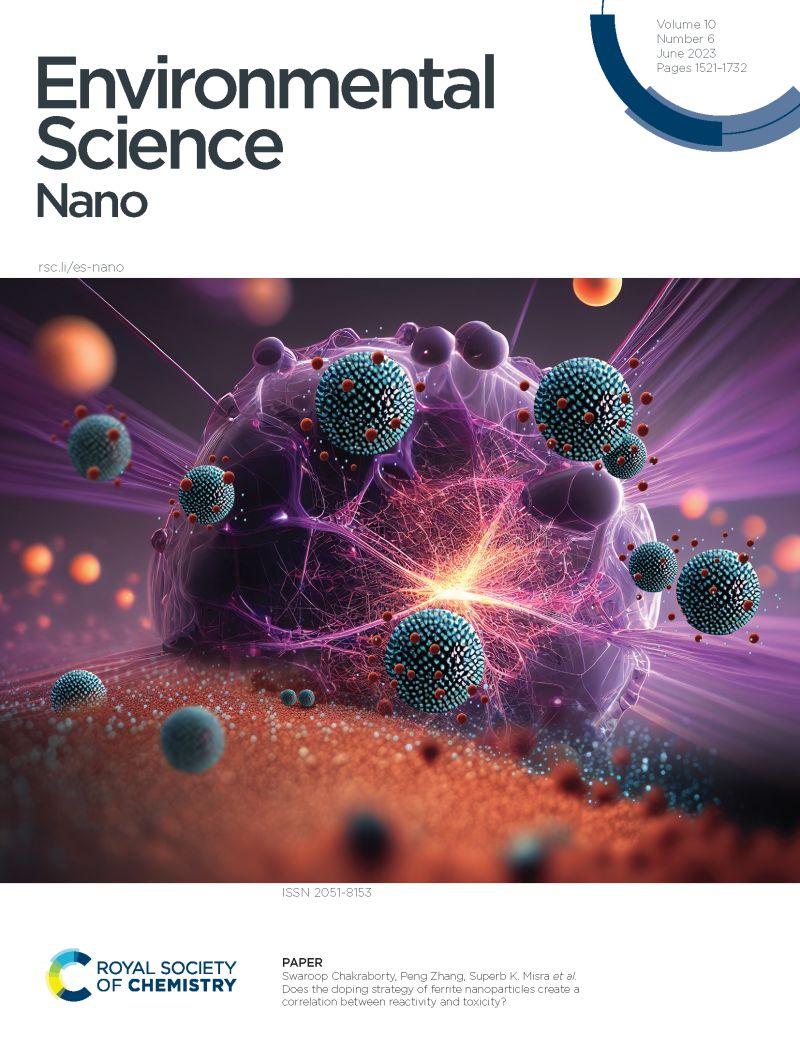了解和预测氧化铁纳米粒子在环境中的扩散:关于合成、表征和建模的综合研究
IF 5.8
2区 环境科学与生态学
Q1 CHEMISTRY, MULTIDISCIPLINARY
引用次数: 0
摘要
氧化铁纳米粒子(IONPs)因其独特的性质而成为用途最广、应用最多的纳米粒子之一。然而,这些纳米粒子(NPs)在环境系统中的分布是一个紧急问题,因为它们的化学形态会产生活性氧(ROS)并对微观和宏观动物/植物产生不可预测的影响。本研究介绍了在 pH 值(5 - 9)、硬度(0 - 400 毫克 CaCO3 L-1)、温度(10 - 30 °C)和暴露时间(0 - 48 小时)受控条件下,评估 IONPs 在水生系统环境介质中的分散情况的策略。为此,使用化学和形态分析技术合成了铁基纳米颗粒(赤铁矿、鹅铁矿和磁铁矿)并对其进行了表征。随后,以总铁为因变量,利用中央复合可旋转设计(CCRD)建立模型,研究了环境参数对纳米粒子分散的影响。合成的 IONPs 尺寸均小于 100 nm。据观察,纳米赤铁矿和磁铁矿呈球形,而鹅卵石呈纳米棒状。由此产生的模型综合了线性、二次和综合效应,显示出很高的预测能力--纳米赤铁矿、鹅卵石和磁铁矿的预测能力分别为 76.4%、93.6% 和令人印象深刻的 99.9%。这项研究有助于了解纳米粒子在自然环境中的行为,为评估和减轻水生环境中 IONPs 污染的不良后果提供了重要见解。本文章由计算机程序翻译,如有差异,请以英文原文为准。
Understanding and Predicting the Environmental Dispersion of Iron Oxide Nanoparticles: A Comprehensive Study on Synthesis, Characterisation, and Modelling
Iron Oxide Nanoparticles (IONPs) are among the most versatile and applied nanoparticles due to their unique properties. However, the distribution of these nanoparticles (NPs) in the environmental system represents an emergency problem for understanding the generation of reactive oxygen species (ROS) and their unpredictable effect on micro and macro fauna/flora due to their chemical form. This study describes strategies to evaluate the dispersion of IONPs in environmental media under controlled conditions of pH (5 – 9), hardness (0 – 400 mg CaCO3 L-1), temperature (10 – 30 °C), and exposure time (0 – 48 h) in aquatic systems. For this purpose, iron-based nanoparticles (hematite, goethite, and magnetite) were synthesised and characterised using chemical and morphological analytical techniques. Subsequently, the effect of environmental parameters on NPs dispersion was investigated by developing a model using a central composite rotatable design (CCRD) with total Fe as the dependent variable. The IONPs were synthesised with a size minor than 100 nm for the three nanoparticles. It was observed that the nano-hematites and magnetites had spherical morphology while goethite appeared as nanorods. The resulting models, integrating linear, quadratic, and combined effects, exhibit high predictive capacities – 76.4%, 93.6%, and an impressive 99.9% for nano-hematite, goethite, and magnetite, respectively. This research contributes to understanding nanoparticle behaviour in natural settings, providing essential insights to assess and potentially mitigate the adverse consequences of IONPs contamination in aquatic environments.
求助全文
通过发布文献求助,成功后即可免费获取论文全文。
去求助
来源期刊

Environmental Science: Nano
CHEMISTRY, MULTIDISCIPLINARY-ENVIRONMENTAL SCIENCES
CiteScore
12.20
自引率
5.50%
发文量
290
审稿时长
2.1 months
期刊介绍:
Environmental Science: Nano serves as a comprehensive and high-impact peer-reviewed source of information on the design and demonstration of engineered nanomaterials for environment-based applications. It also covers the interactions between engineered, natural, and incidental nanomaterials with biological and environmental systems. This scope includes, but is not limited to, the following topic areas:
Novel nanomaterial-based applications for water, air, soil, food, and energy sustainability
Nanomaterial interactions with biological systems and nanotoxicology
Environmental fate, reactivity, and transformations of nanoscale materials
Nanoscale processes in the environment
Sustainable nanotechnology including rational nanomaterial design, life cycle assessment, risk/benefit analysis
 求助内容:
求助内容: 应助结果提醒方式:
应助结果提醒方式:


